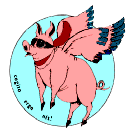| The Journal of Provincial Thought |
|
 |
|||||||||||
 |
||||||||||||
| Brasserie Dieu Du Ciel! arranged by Sister Judy of the Several Passions |
||||||||||||
 |
||||||||||||
| No. 008 | Professor Loose | |||||||||||
| The Rise of the Reptilian Brain | ||||||||||||
| and the Gnashing of Teeth | ||||||||||||
|
Once a pons a brain stem, in a swamp a long, long time ago fish got uppity and started walking on their fins. In our Genesis Travelogue we have arrived at the fifth day. Up to this point we have seen that Genesis 1 is consistent with the cosmologic concepts of the Big Bang, the formation of matter and heavier elements and planetary differentiation. We have seen how plants (in the form of algal mats) had changed the atmosphere enough to make the sun, moon and stars distinctly visible for the first time in about 4 billion years. Now we have come to the age of fishes. According to geologic theory as supported by the fossil record, macroscopic life started in the oceans as various sea creatures. It is not my purpose to give a complete account of marine biology, rather to point out that it is written “on the fifth day the oceans [waters] brought forth life,” various sea creatures and birds being mentioned. That birds appear along with fishes may strike some as rather odd. However, the fact that birds are said to have formed from the waters on this “day” implies that the period also brings the age of reptiles, including the dinosaurs. It was only about 15 years ago that some suggested that birds are the descendants of dinosaurs. Now the idea is pretty much accepted by mainstream scientists as fact. Tyrannosaurus Rex was a 30-foot-tall rooster. You think a bear with cubs is threatening, try motoring your hog through a nest of 30-foot roosters![1] Actually, birds have changed some since their branching from reptiles millions of years ago but they are still a remnant of the dinosaur age. Keep an eye on that parakeet; it has an agenda of reconquest. I am not oblivious that the idea that birds and reptiles could have evolved from sea squirts and sponges sounds preposterous. But, if one were to think that sponges were a working prototype for lungs and sea squirts were a working prototype for colons, jelly fish for hearts, etc., then one can realize that 99 percent of what we physically are now started as prototypes in the oceans. We still start out in a larval state swimming through the sea. The smart one that asks for directions wins the babe and the rest is fetal history. (Do I need to elaborate? Babies don’t come from storks.[2]) The big issue is round versus long. Being spherical entails various issues relating to the ratio of surface area to volume, but the biggest concern is mobility and maneuverability. When there is something always trying to eat me I would rather be a swift torpedo than a sluggish beach ball. But if you are long you have to have a long nervous system and then you have to protect it. There is the issue of the constant escalation of armor plating, and everything starts getting complicated. Let us curl our fins and contemplate our Inner Fish.[3] The basic biologic fact is that all our vital functions reside in our spinal column and brain stem. There are also various concentrations or ganglia of nerves throughout our body, such as the solar plexus (these just so happen to coincide with what are known as chakras, but don’t get me started! [4]). There are a few other structures on the brainstem, such as the pons, which are common to all vertebrates, from the simplest fish to reptiles, birds and us. This complex of brainstem and structures is, in fact, known as the reptilian brain.[5] The rise of the reptilian brain is a very important concept from the standpoint of the multidimensional nature of the universe. For about 13 billion years there were carlsagans[6] of particles bouncing around and interacting at the scale of the universe itself, resulting in stars and galaxies. These galaxies form a pattern of distribution that I submit is not random. We will eventually figure out what the pattern of galaxies is. I think the pattern that we see will look like a person peering through a telescope at us. With onset of microscopic, unicellular life we see the interaction of carlsagans of particles (molecules) interacting on the scale of a single cell, each system of molecules consisting of carlsagans of atomic particles. With the rise of the reptilian mind we see the interaction of carlsagans of cells. Billions of these reptilian ‘units’ can now interact on the scale of the planet. Thus, what I mean by the multidimensional universe is that each reptilian 'unit' is a universe within itself. Our reptilian brain keeps us alive. It is responsible for our breathing, heartbeat, digestion, and heavy-breathing steamy sex drive. Sensibility is not one of its strong points, however. Do not try to reason with a 30-foot rooster if you are in its tree. It will eat you. Territoriality, aggression, ritual (dewlap flapping and dancing among lizards, birds, fish, etc.) and the attendant fascination with rhythmic vibrations (e.g. the sand worms of Dune) are primary preoccupations of the Reptilian Brain. Basically all the cool things that fish, reptiles and birds do we can also do, but not as well. One of the silliest things I have heard people say is that animals don’t have feelings. However, the lowly crocodile rejoices at the kill and is happiest when slashing, crushing, chomping—both giving and receiving. The reptilian mind loves the thrill of the fight with adrenaline coursing through veins, switchblade in claw taking down the big daddy gator. Rumble in the jungle, shrieking at the moon like the animals-they-be. The reptilian mind is pure ecstasy, totally unrepressed joy. The reptilian mind has no fear; it only has the urge for violence and sex. If adrenaline doesn’t do it, then endorphin will. The fact is, we humans are still dominated 90-99 percent by the reptilian brain. I must say as a human that I highly resemble that statement. The next-silliest thing I hear people say is that we should not “anthropomorphize.” We see some lizards flashing the dewlaps on their neck at each other and dancing around like ballerinas and we say, “Look at those lizards! They are rocking out, dude!” We are not supposed to do that because we are attributing human behaviors to mere animals. The ironic thing is that when we are rocking out, flashing our bling, feathering our nests, and dousing ourselves with smell-good juice we are being quite reptilian. This is not a value judgment. This is not saying that being reptilian is evil, as many would say. Being reptilian is our greatest source of joy and pleasure. It is also, however, our greatest source of pain and destruction. Greed is in the mind of the hoarding croc. Actually, that is a technically false statement. Crocs only do what they do as driven by their reptilian brains. Only reptiles with a cortex can be greedy. Only when crocs can make weapons and formulate banking systems that turn war into profit can there be greed. That dubious honor, my dear mammal mates, will fall upon us—the Reptiles Extraordinaire. Nevertheless, following the age of fishes and reptiles in our reconstruction of the days of the world, it will take a few more million years and a rather large block of ice before we arrive and ruin all the fun. [1]Commentator: The Professor alludes to attorney John Rice’s motorcycling encounter with bears, that drama notably documented in the Journal of Provincial Thought issue #14. It wouldn’t surprise us if John’s travels and adventures HAD in fact taken him through a wormhole and a nest of T-Rexa. [2] Clever Attendee: So where do baby storks come from? [3] Your Inner Fish: A Journey into the 3.5 Billion year History of the Human Body. Neil Shubin. [4] Stubborn/thick Attendee: What are chakras? [5] The Human Brain Book. Rita Carter. [6] “billions and billions” |
||||||||||||
|
||||||||||||
| Copyright 2009- WJ Schafer & WC Smith - All Rights Reserved | ||||||||||||